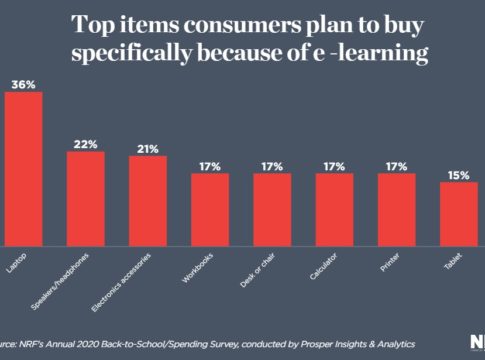Most families still don’t know what supplies students need for school and college this year, but more expect at least some classes to take place online than a month ago and say they are buying more computers and other items to be ready, the National Retail Federation and Prosper Insights & Analytics said today.
“Consumers still face a great deal of uncertainty even as school begins to start and are further behind in their back-to-school spending than they have been in years,” NRF President and CEO Matthew Shay said. “At this point, the majority of families expect to spend as much as they thought earlier this summer if not more, and it’s largely because of the need to spend more on electronics.”
An update of NRF’s annual back-to-class survey conducted in early August found 63 percent of consumers expect at least some school and college classes will take place online this year, up from 55 percent when the original survey was conducted in early July. Of those, 76 percent plan to make purchases specifically because of online learning, up from 72 percent. While the number planning to buy laptops is essentially unchanged at 37 percent rather than 36 percent, the number buying accessories such as a mouse or flash drive is up at 26 percent from 21 percent and the number expecting to buy desks or chairs to furnish home classrooms rose from 17 percent to 23 percent.
The survey found 34 percent expect to spend more than they thought in July, and 54 percent said that’s because they plan to spend more on electronics and computer equipment. But with growing children needing new clothes whether they are at school or at home and many supplies needed either way, 47 percent said they are spending more on clothing and 59 percent said the higher spending would come in the form of school supplies such as pencils and notebooks. Only 25 percent expect to spend less, and 42 expect to spend the same as they thought in July.
The update did not ask the actual amount consumers expect to spend. As of July, shoppers with children in kindergarten through high school said they planned to spend an average $789.49 per family for a total of $33.9 billion while those with college students planned to spend an average $1,059.20 per family, or $67.7 billion total.
Only 34 percent of consumers had received school supply lists by early August, up from 10 percent in July, but still leaving most waiting for more clarity before they could finish shopping.
K-12 shoppers had completed only 41 percent of their buying on average, down from 54 percent at the same time last year and the lowest level since 40 percent in 2012. College shoppers had completed 50 percent, down from 52 percent each of the past two years but higher than the 48 percent average over the past dozen years.
Among those who had not completed at least half their shopping, 46 percent of K-12 shoppers and 48 percent of college shoppers said it was because they did not know what they would need. For both groups, 46 percent planned to do the remainder of their shopping online, up from 34 percent at the same time last year for K-12 and 38 percent for college.
“With many schools still not clear on whether students will be in the classroom or learning at home, parents have to be prepared for both,” Prosper Insights Executive Vice President of Strategy Phil Rist said. “Nonetheless, a growing number of parents expect students to be at home.”
The survey of 7,569 consumers was conducted August 3-11 and has a margin of error of plus or minus 1.2 percentage points.





